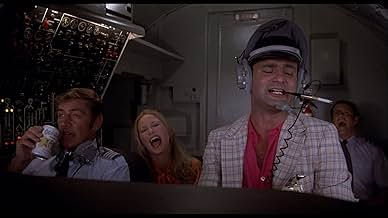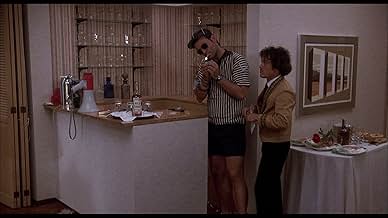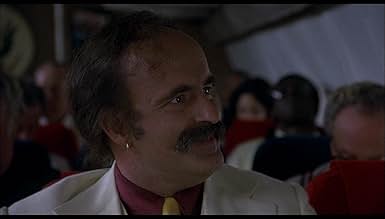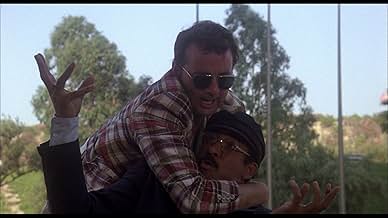Bill Murray spielt den exzentrischen Untergrund-Journalisten Hunter S. Thompson, der in den 60er und 70er Jahren neben dem Schreiben vor allem für seine Liebe zu Drogen aller Art, Gewalt und... Alles lesenBill Murray spielt den exzentrischen Untergrund-Journalisten Hunter S. Thompson, der in den 60er und 70er Jahren neben dem Schreiben vor allem für seine Liebe zu Drogen aller Art, Gewalt und durchgeknallten Aktionen bekannt wurde.Bill Murray spielt den exzentrischen Untergrund-Journalisten Hunter S. Thompson, der in den 60er und 70er Jahren neben dem Schreiben vor allem für seine Liebe zu Drogen aller Art, Gewalt und durchgeknallten Aktionen bekannt wurde.
- Harris
- (as René Auberjonois)
- Billy Kramer
- (as Jon Matthews)
- Pilot
- (as Quinn Redeker)
Empfohlene Bewertungen
It does play a bit like Caddyshack, as someone else pointed out, and it's hard to get really invested in the characters. And if you love HST as much as I do, you really do want to get into the characters and in to the story, because it's as important as it is funny. Where the Buffalo Roam is, for the most part, silly. It comes off as more a bunch of sketches than anything else. I did like Bill Murray in the part. The problem is the script, more than anything else.
Fear and Loathing in Las Vegas, by contrast, does well with the surrealism and depravity but fails to make the full point I think Thompson was trying to get across - the decadence and over-the-top performances (especially of del Toro) are distracting, and really all of this is supposed to be about the death of the American dream, and the end of what was (to some) the best decade on record, or at least the one where people thought, for a time, they could make something of American life. Both movies hint at this but don't go into it enough, in my opinion.
Where the Buffalo Roam captures a little of the sadness and the creeping hopelessness of the early 70s (along with an indication of the hangover awaiting that generation in the 70s), but both movies fall far short of Thompson's books and writing in my opinion.
I was particularly saddened that both movies left out the "We're looking for the American dream" bit at the taco stand, because I think that was important, and the F&L Vegas story seems decontextualized without it (in terms of having a fairly serious (and sad) point under all of the humor and excess).
In any case, both movies are worth a watch but ultimately unsatisfying. Thompson is still best read. I think a good film about HST can be made, but the right person needs to be at the helm.
Richard Linklater or John Sayles, perhaps...someone who isn't going to miss the deeper substance underlying and buttressing the humor. That being said, there are far worse movies you could be watching than either.
And like Thompson, it still hasn't gotten weird enough for me.
Bill Murray is fantastic in this film. His portrayal of HST is taken from life, more realistic, more from the man rather than from his text or the legend of HST. The whole film itself, mainly because of Murray's characterization and the realistic structured style of the abrupt interconnected randomness of everyday life, is infused with a undying sense of fun and love for words, imagination, writing, and the whole creative process, which seems to me to get more to the core of HST as a man than the various vignettes of Fear & Loathing.
Where The Buffalo Roam is wildly entertaining, frenziedly hilarious, and immeasurably fun. But when the general viewing audience, who presumably do not have a true passion for HST and his works, views both films and are given the choice between the legend and the man, they more often choose the legend, which is usually the trend in history.
Whereas Fear & Loathing In Las Vegas has a romance for the stories and the myth, Where The Buffalo has a romance for the man and the process, and both have it for his personal style, politics and priorities.
On the plus side, this film is wickedly funny. Bill Murray (an actor who has been both great and terrible in his career) does a phenomenal job as the acid-drenched reporter, bringing chaos into the lives of the rigid and pretentious. The plot is peppered with "respectable" places being dragged into mayhem, and "respectable" folks trying (unsuccessfully) to cope behind plastic smiles.
It even ventures into some higher themes, such as innocent kids being jailed by a heartless criminal system, and Thompson's own struggles between being a practical reporter and a fun-loving idealist (notice how Lazlo repeatedly re-surfaces just when Thompson starts to take on "real" jobs).
It's biggest fault, however, was that it failed to achieve any of the higher accomplishments of HST's writings. What makes Thompson such a powerful writer (to me, anyway) is the way he'll often turn on a dime and deliver stunningly sober dialogs on the human animal and where he's gone wrong. Nestled in the midst of the wine, women, and song are soliloquies that drive home a more positive message, and none of those made it into this film (in fact, no significant chunks of actual text from HST's books appeared at all). It's like they shaved off the surface 50% of Thompson's work and discarded the rest.
Compare this to Fear and Loathing, which was darker and more counter-cultural, and contained whole narrations excerpted from the novel. The latter perhaps has less appeal to the average viewer, but I'd think more to a Thompson fan.
All-in-all, this film is a light-hearted romp into anarchy, and worth watching. But if you've never actually READ Thompson, do so, as this movie doesn't accurately represent him.
Wusstest du schon
- WissenswertesTo get into character, Bill Murray spent time with Hunter S. Thompson by drinking, shooting and generally having a great time at Thompson's Colorado ranch. After filming ended, Murray continued to act "Gonzo" through the beginning of the next season of Saturday Night Live (1975), to the annoyance and consternation of cast and crew members.
- PatzerDuring the courtroom scene, 21 minutes and 5 seconds into the film, Thompson sets down his glass which is almost full. A second later, a close-up on the glass shows it sitting on the floor, empty. All further scenes in the courtroom show the glass once again almost full.
- Zitate
[Thompson is speaking to a crowd of college students]
Questioner: I was just wondering if you could tell me, um, if you thought drugs and alcohol would make me a better writer.
Dr. Hunter S. Thompson: That's a good question. Let me see...
[the audience cheers as Thompson lights a joint. A few people throw joints onto the stage]
Dr. Hunter S. Thompson: In my case, you know, I hate to advocate drugs or liquor, violence, insanity to anyone. But in my case it's worked.
- Alternative VersionenThe 2017 Blu-ray release from Shout! Factory restores the original soundtrack. Making this the first home media release since the original VHS release to feature the original unaltered soundtrack.
- SoundtracksKeep on Chooglin
Written by John Fogerty
Performed by Creedence Clearwater Revival (as Credence Clearwater Revival)
Top-Auswahl
Details
Box Office
- Bruttoertrag in den USA und Kanada
- 6.659.377 $
- Eröffnungswochenende in den USA und in Kanada
- 1.750.593 $
- 27. Apr. 1980
- Weltweiter Bruttoertrag
- 6.659.377 $
Zu dieser Seite beitragen



































